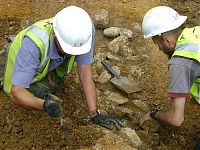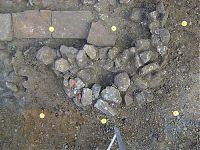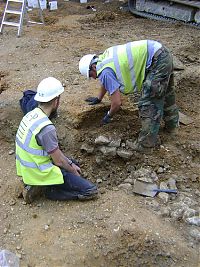Bodysnatchers of the Monkey King
- By: Anies Hassan |
- Sep 19, 2008
- Share
- del.icio.us

We’ve all been there .. the classic situation .. you wait ages for a bus and then three come at once. It’s been a bit like that here. Over the last few months we have found occasional truncated and badly preserved Roman burial, and in the last few weeks we found clusters of very well preserved Roman inhumations and elaborate cremations. We have found a burial cluster within the last week or two, to the very East of the site, that seems to contain almost every variety of burial. We have had inhumations orientated East-West, West-East, North-South, South-North, with coffins, without coffins, with grave-goods and without, and a child buried covered in chalk dust and with a “chalk dust pillow”. One of the most striking of the burials that we came across, however, was what we first assumed to be the foundation of a wall running East-West. Once we cleaned this anomaly up it soon became apparent that what we had was some kind of “stone-lined grave”… (or so we thought)
During previous excavations of the Eastern cemetery four structures, or mausoleums have been found associated with inhumation burials. All four were found much closer to City wall, so we were not expecting to find anything like this here. I kind of had a feeling a few weeks back that what we had here was an area of low-status burials. That feeling dissolved last week with the discovery of two high-status cremations (read Ruth’s and Will’s most recent journal entries) but all the other inhumation burials seemed fairly ‘normal’.
Back to our stoned lined grave Context: 1839 .. It had four large tiles running down its central axis (about 1.6m maximum in length) which confused us a bit .. were they capping the inhumation or were they the base of the inhumation, on which the body would have rested? Only one way to find out, and that’s to excavate it. After taking some geo-photos of it we were ready to get stuck in. Within minutes, we realised that these tiles were in fact the base of the burial and that they formed the surface on which the body was laid to rest. We found a few nails around the tiles, indicating that maybe the body had been placed in a coffin or, more likely, were part of a wooden sub-structure. Whatever the situation, the body was gone and so were any grave goods that may have been placed with him or her. All that remained was not stone lining but actually an 80cm thick foundation of rag-stone, flint and occasional chalk bonded with silty gravel. Whatever was on top of this foundation could have been fairly substantial and would have certainly been constructed for someone of significant status. Status significant enough for persons unknown to return at an unknown point in time to desecrate the tomb and rob it of not only the grave goods but also the body. It’s actually more likely that the skeleton simply degraded after exposure but, for the sake of drama, I’ll stick with the body-snatcher theory.
Finally, I’ll end with two questions. Firstly, directly under the tiles we found a gravely deposit containing a dense concentration of burnt bone. What was that doing there? We have sent that off for analysis, so at some point we should find out if the bones were animal or human. Is it possible that the burnt bone was the actual individual (making this one of the most elaborate cremations ever found)? Probably not, but I’d like to know why it was there. Lastly, who was the person? The space for the body was very short at only about 1.6m long so was this a child? This is the most likely scenario but I have a personal theory that it was either a dwarf or almost certainly the Roman Monkey King. Everybody agrees with me and the beauty of the theory is that there is no direct evidence to dispute it. Archaeology, you’ve gotta love it!
- (0)


